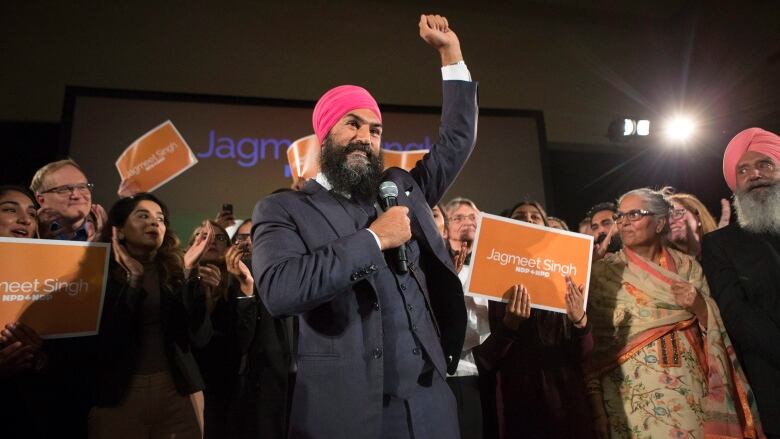How Jagmeet Singh won the NDP leadership
Singh unexpectedly wins on the 1st ballot with 53.8% of valid votes cast

JagmeetSingh pulled off a surprise on Sunday by winning the NDP leadership on the first ballot, handily defeating his rivals in a performance matched only by past NDP stalwarts Tommy Douglas and Jack Layton.
Fundraising, polls and membership sign-ups suggested that Singh was on track for a strong first ballot result. The question wasn't about wherehe would place, but whether he would get overthe 50 per cent mark needed to avoid a second round of voting.
In hindsight, however, it appears that Singh had all but won this race over a month ago.
When the membership sign up deadline passed in mid-August, Singh's campaign quickly announced thatthey had signed up more than 47,000 members, representing about 57 per cent of all new members signed up in the course of the campaign and 38 per cent of the 124,000 members eligible to vote.
While not all of Singh's sign-upsturned out on Sunday he won with 35,266 votes, representing 53.8 per cent of the total a clearly significant percentage of them cast a ballot. Overall turnout was 52.8 per cent, but turnout among his supporters appears to have been markedly higher.
There were strong indications throughout the campaign that Singh's support was largely being drawn from new members. Pre-existing members of the party were instead opting for sitting MPs and long-time party figures Charlie Angus, Niki Ashton and Guy Caron.
But those three only had 30,243 votes between them. The number of pre-existing party members and new members that weren't signed up by Singh's campaign totaled about 77,000. Undoubtedly, some of them voted for Singh. But a disproportionately low number of them turned out for his opponents.
Angus under-performs
That was especially the case for Angus.
The Northern Ontario MP was second in fundraising and second in the polls. In these metrics, there was a significant gap between him and the rest of the field.
In the end, Angus took just 19.4 per cent of the vote, well below his target. He had 26 per cent of the fundraising and contributors. Another 10 or so points in his favour and he would have been at 29 per cent, Singh at 44 per cent and the race would have been up for grabs going into a second and third round, where Angus was better positioned to win the votes from the supporters of Ashton and Caron.
That was the plan, anyway.

Ashton, at 17.4 per cent, and Caron, at 9.4, both did about as well as expected. For Ashton, it was a significant improvement over the5.7 per cent she securedin the 2012 leadership contest. For Caron, he showed he had some appeal outside of his own province of Quebec. The province that sent the most NDP MPs to Ottawa in 2015 was home to just 4 per cent of eligible voters.
But that Ashton and Caron were able to finish about as expected highlights thepoor performance of Angus. Had there been a bigger gap between him and the bottom two finishers, Singh's win could be chalked up entirely to turnout and his bigger membership sales. But a not insignificant contributor to Singh's first ballot victory is the failure of his chief rival to get his supportersto vote.
Money talks
The first ballot results of the 2003 and 2012 leadership votes aligned nearly perfectly with the fundraising prowess of the leadership contestants during those campaigns. That trend was not repeated on Sunday, as Singh beat his fundraising share by about 10 points at the expense of Angus and Caron.
But if we only look at the fundraising totals of the candidates since Singh's entry into the campaign, the numbers line up more closely.
Between May and the second week of September the last date for which fundraising data is available Singh raised 53 per cent of all the money raised by the four candidates. He was followed by Angus at 20 per cent, Ashton at 16 per cent and Caron at 11 per cent.
That matches the results quite closely. The potential for Singh's first ballot victory was hiding in plain sight.

That suggests the fundraising figures can tell us something about how Singh won. Without regional breakdowns of turnout and results, which the party says it won't be releasing, the fundraising data is all we have to go on.
It indicates that Singh's support was largely drawn from his home region of the Greater Toronto Area, which alone represented two-thirds of his fundraising.Along with the GTA, the data suggests Singh won enough support from members in British Columbia (Singh was the only candidate to have campaign offices in both Ontario and B.C.), Greater Montreal, Southwestern Ontario and Alberta to put him over the top.
Anything you can do, I can do better
The next challenge for Singh, the 2019 election, will prove to be more difficult. One thing going in his favour is the historical performance of the NDP, which has never had two consecutive elections in which the party has lost both vote and seat share.
That will be a tall order for Singh. Despite the drop from the party's 2011 breakthrough, the NDP won 44 seats and 19.7 per cent of the vote in the 2015 federal election its second and third best performance, respectively, in its history. With the partynow polling at 15 per centand at risk of more than half of its caucus disappearing, Singh already has a steep mountain to climb just to match results that weren't good enough for former leader Tom Mulcair to keep his job.
But he has already smashed expectations by winning on Sundayin stunning fashion, becoming only the third person, after Douglas and Layton, to win the NDP leadership on a single ballot. To put him in such august company, New Democrats must believe he can continue to defy expectations.















_(720p).jpg)


 OFFICIAL HD MUSIC VIDEO.jpg)
.jpg)



























































































